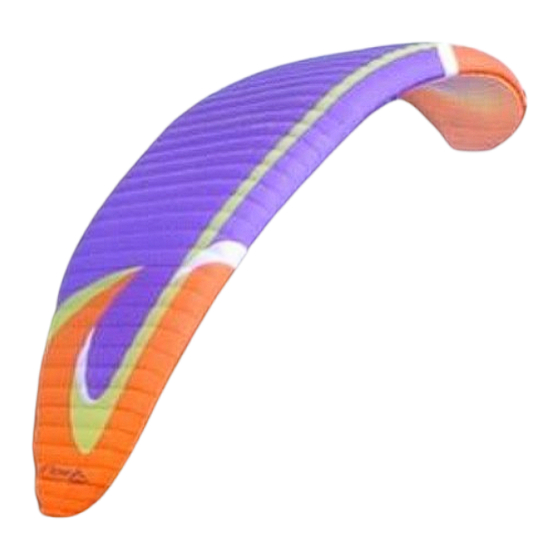
Table of Contents
Advertisement
Quick Links
Advertisement
Table of Contents

Summary of Contents for Flow Paragliders Cosmos
-
Page 2: Welcome
WELCOME Thank you for flying Flow Paragliders. We hope you will be satisfied with this product and wish you many happy flights. We strongly recommend that you read this manual before the first flight. This manual is designed to help you to quickly familiarize with this beautiful glider. -
Page 3: Table Of Contents
Welcome 15. Warranty 1. General Information 16. Summary 2. Certification 17. Line Plan 3. Pilot’s Profile 18. Riser Diagram 4. Specifications 19. Overall Illustration 5. Take Off and Flying Techniques 20. Materials 5.1 Before take-off 21. Line Measurements 5.2 Take-off 22. -
Page 4: General Information
User manual for Cosmos XS, Cosmos S, Cosmos M and Cosmos L The Flow Cosmos is an easy and fun paraglider with excellent glide and a very efficient speed system designed as a low end EN B class glider. The Cosmos is aimed at pilots who are willing to progress in the sport safely, chasing their first XC flights but who are also comfortable with the technical control of this type of glider. -
Page 5: Pilot's Profile
PILOT’S PROFILE The Cosmos was designed to be nothing but a fun paraglider. With that in mind we concentrated on the handling and the fun factor of the glider. Coupled with a shark nose profile and reduced line plan we have a glider which sits in the low end of the EN B class. -
Page 6: Specifications
SPECIFICATIONS FLAT AREA 24.2m2 25.80m2 27.3m2 29.3 m2 PROJECTED AREA 21m2 22.22m2 23.44m2 25.47m2 FLAR WINGSPAN 11.18m 11.55m 11.88m 12.34m PROJECTED SPAN 9.05m 9.29m 9.48m 10.03 ASPECT RATIO 5.17 5.17 5.17 5.17 PROJECTED AR MAX CHORD 2.65 2.73 2.81m 2.93 NUMBER OF CELLS GLIDER WEIGHT TAKE OFF WEIGHT... -
Page 7: Take Off And Flying Techniques
The Cosmos was designed as a foot launchable solo paraglider and can also be tow-launched. It is the pilot’s responsibility to use suitable harness attachments and release mechanisms and to ensure that they are correctly trained on the equipment and system employed. -
Page 8: Landing
Turning Flow Cosmos was designed to perform well in turns. Negative steering (see above) on one hand slows the paraglider in certain phases of the flight and on the other hand reduces excessive rolling during turn reversals. It is not only designed to turn (with approx. 30% brake) but also to fly slowly in order to help identify the areas of lift and to keep the paraglider flatter to minimize the sink rate in a turn (with 15% brake). -
Page 9: B-Line Stall
Use of Brakes Flow Cosmos’s best glide is at a trim speed (no brakes) – about 38 km/h. The minimum sink rate is achieved by applying approx. 15% of the brakes. When using more than 30% of the brakes, the aerodynamics and the performance of the glider are likely to deteriorate and the effort to manoeuvre will increase quickly. -
Page 10: Asymmetric & Frontal Collapses
ASSYMETRIC & FRONTAL COLLAPSES Despite the tests proving Cosmos recovers on its own after collapses, it is a EN B glider therefore active piloting is recommended in case of an asymmetric or frontal collapse. Active piloting will reduce the loss of altitude and a change of direction. -
Page 11: Full Stall
FLYING WITHOUT BRAKES If a brake line or pulley breaks, it is possible to fly the Cosmos using the C-risers (rear riser). The movements must be well controlled as the deformation of the wing, due to the traction on the B-risers, is greater than that produced by using the brakes. -
Page 12: Siv
All manoeuvres should be carried by the supervision of experienced paragliding instructors, above water and rescue boat. ADJUSTMENT OF THE HARNESS For test flights, the pilots used ABS harnesses with the following set-up: SIZE Distance from seat board Distance between hang points COSMOS XS 43cm 44cm COSMOS S 43cm 46cm... -
Page 13: Maintenance & Checks
MAINTENANCE & CHECKS The Flow Cosmos is a robust piece of equipment but as any flying aircraft it should be technically periodically checked to ensure proper airworthiness. Maintenance Tips The life of your paraglider therefore depends largely on the care which you maintain and use it. To maximize life span of your wing, respect the following rules: •... -
Page 14: Warranty
WARRANTY The Flow Cosmos is guaranteed for two years or 250 hours against any production fault since the date of purchase. The guarantee does not cover: • Damage caused by misuse • Neglecting the regular maintenance • Overloading or misuse of the glider •... -
Page 15: Line Plan
LINE PLAN... -
Page 16: Riser Diagram
RISER DIAGRAM Sizes XS, S Sizes M, L... -
Page 17: Overall Illustration
OVERALL ILLUSTRATION... -
Page 18: Materials
For spare parts or information in how to obtain them get in contact with us directly or with your local dealer. Flow Paragliders PTY LTD. 1/24 Clyde Road, Dee Why, NSW 2099, AUSTRALIA – Tel: +61 414 966 092 –... -
Page 19: Line Measurements
LINE MEASUREMENTS...


Need help?
Do you have a question about the Cosmos and is the answer not in the manual?
Questions and answers